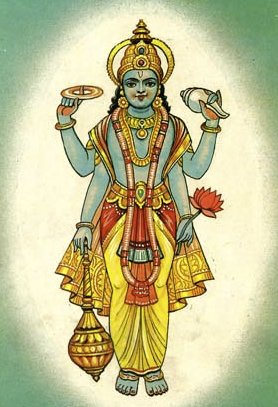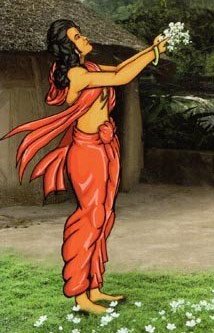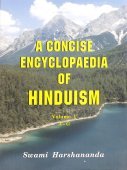Damayanti, Damayantī, Damayamti: 16 definitions
Introduction:
Damayanti means something in Hinduism, Sanskrit, Jainism, Prakrit. If you want to know the exact meaning, history, etymology or English translation of this term then check out the descriptions on this page. Add your comment or reference to a book if you want to contribute to this summary article.
In Hinduism
Purana and Itihasa (epic history)
Source: Wisdom Library: Bhagavata PuranaDamayantī (दमयन्ती):—She was the hife of Saudāsa (son of Sudāsa). (see Bhāgavata Purāṇa 9.9.18)
On another occasion she is reffered to as Madayantī (see Bhāgavata Purāṇa 9.9.23-24 etc.)
Source: archive.org: Puranic Encyclopedia1) Damayantī (दमयन्ती).—Daughter of Bhīma the King of Vidarbha The most noble of all the Indian heroines, Damayantī has secured a place in the literatures of almost all the languages in the world. The famous hero Nala is her huband. The background of the story of Nala. During the time of the forest life of the Pāṇḍavas, Arjuna had gone to Kailāsa to do penance before Śiva for getting divine weapons. The rest of the Pāṇḍavas spent the time till the arrival of Arjuna, in sorrow and sadness. They spent miserable days one by one. At that time the hermit Bṛhadaśva visited them. They welcomed the hermit. In the midst of their conversation Dharmaputra told the hermit with tears that he was the most unhappy man in the world. Hearing this the hermit told them the story of Nala, to console the Pāṇḍavas. (See full article at Story of Damayantī from the Puranic encyclopaedia by Vettam Mani)
2) Damayantī (दमयन्ती).—The daughter of Pramloca. See Viśvakarmā, 2nd para.
Source: Archaeological Survey of India: Śaiva monuments at Paṭṭadakal (mahābhārata)Damayantī (दमयन्ती).—Nala and Damayantī are the king and queen of a kingdom. He is very fond of dice play and once in that game he loses everything including his realm. The king and the queen go in exile. As hard times do not come singularly, one night even his dhoti is stolen by birds. Then the king abandons his wife, starts roaming alone in the forest.

The Purana (पुराण, purāṇas) refers to Sanskrit literature preserving ancient India’s vast cultural history, including historical legends, religious ceremonies, various arts and sciences. The eighteen mahapuranas total over 400,000 shlokas (metrical couplets) and date to at least several centuries BCE.
Vaishnavism (Vaishava dharma)
Source: ISKCON Press: GlossaryDamayantī (दमयन्ती).—The queen of King Nala who burnt a hunter to ashes by her curse when he attempted to molest her.

Vaishnava (वैष्णव, vaiṣṇava) or vaishnavism (vaiṣṇavism) represents a tradition of Hinduism worshipping Vishnu as the supreme Lord. Similar to the Shaktism and Shaivism traditions, Vaishnavism also developed as an individual movement, famous for its exposition of the dashavatara (‘ten avatars of Vishnu’).
Kavya (poetry)
Source: Wisdom Library: KathāsaritsāgaraDamayantī (दमयन्ती) is the daughter of king Bhīma, according to the Kathāsaritsāgara, chapter 56. Accordingly, “he [Nala] had no wife, and when he made inquiries he heard that Damayantī, the daughter of Bhīma, the King of Vidarbha, would make him a suitable wife. And Bhīma, searching through the world, found that there was no king except Nala fit to marry his daughter [Damayantī]”.
The story of Damayantī was narrated by Sumanas to queen Bandhumatī in order to demonstrate that “reunions do take place, even of the long separated”, in other words, that “great ones, after enduring separation, enjoy prosperity, and following the example of the sun, after suffering a decline, they rise again”.
The Kathāsaritsāgara (‘ocean of streams of story’), mentioning Damayantī, is a famous Sanskrit epic story revolving around prince Naravāhanadatta and his quest to become the emperor of the vidyādharas (celestial beings). The work is said to have been an adaptation of Guṇāḍhya’s Bṛhatkathā consisting of 100,000 verses, which in turn is part of a larger work containing 700,000 verses.

Kavya (काव्य, kavya) refers to Sanskrit poetry, a popular ancient Indian tradition of literature. There have been many Sanskrit poets over the ages, hailing from ancient India and beyond. This topic includes mahakavya, or ‘epic poetry’ and natya, or ‘dramatic poetry’.
General definition (in Hinduism)
Source: WikiPedia: HinduismDamayantī (दमयंती): She is the wife of Nala whose story is told in the Mahabharata.
In Jainism
General definition (in Jainism)
Source: JAINpedia: Women in the Jain tradition: Soḷ satīDamayantī (दमयन्ती) refers to one of the 16 Satīs mentioned in the Brāhmī Candanbālikā.—In Jain contexts “Satī” revolves around fidelity to the Jain religion. Although Jains call many virtuous Jain women satīs, among Śvetāmbara Jains there is a group of satīs called the soḷ satī or 16 Satīs (i.e., Damayantī). These Jain Satīs are revered as role models for women and their stories are widely known. Even though the general group of Satī grows over time, the group of 16 Satīs is unchanging.

Jainism is an Indian religion of Dharma whose doctrine revolves around harmlessness (ahimsa) towards every living being. The two major branches (Digambara and Svetambara) of Jainism stimulate self-control (or, shramana, ‘self-reliance’) and spiritual development through a path of peace for the soul to progess to the ultimate goal.
Languages of India and abroad
Sanskrit dictionary
Source: DDSA: The practical Sanskrit-English dictionaryDamayantī (दमयन्ती).—
1) Name of the daughter of Bhīma, king of the Vidarbhas. [She was so called because by her matchless beauty she subdued the pride of all lovely women; cf. N.2.18 :-भुवनत्रयसुभ्रुवामसौ दमयन्ती कमनीयतामदम् । उदियाय यतस्तनुश्रिया दमयन्तीति ततोऽभिधां दधौ (bhuvanatrayasubhruvāmasau damayantī kamanīyatāmadam | udiyāya yatastanuśriyā damayantīti tato'bhidhāṃ dadhau) || A golden swan first described to her the beauty and virtues of king Nala, and through him she communicated her love to Nala. Afterwards at the Svayaṃvara she chose Nala for her husband from out of a host of competitors among whom were the four gods Indra, Agni, Yama, and Varuṇa themselves, and the lovely pair spent some years very happily. But their happiness was not destined to last long. Kali, envious of the good fortune of Nala, entered his body, and induced him to play at dice with his brother Puskara. In the heat of the play the infatuated monarch staked and lost everything except himself and his wife. Nala and Damayantī were, therefore, driven out of the kingdom, 'clad in a single garment'. While wandering through the wilderness, Damayantī had to pass through several trying adventures, but her devotion to her husband remained entirely unshaken. One day while she was asleep, Nala in the frenzy of despair abandoned her, and she was obliged to go to her father's house. After some time she was united with her husband, and they passed the rest of their lives in the undisturbed enjoyment of happiness. See Nala and Ṛituparna also.]
2) Name of a flowering plant (Mar. mogarī).
Source: Cologne Digital Sanskrit Dictionaries: Benfey Sanskrit-English DictionaryDamayantī (दमयन्ती).—fem. of the pres. ptcple. of the Causal of dam, A proper name, [Nala] 1, 9.
Source: Cologne Digital Sanskrit Dictionaries: Cappeller Sanskrit-English DictionaryDamayantī (दमयन्ती).—[feminine] [Name] of the wife of Nala.
Source: Cologne Digital Sanskrit Dictionaries: Monier-Williams Sanskrit-English Dictionary1) Damayantī (दमयन्ती):—[from dam] f. ‘subduing (men)’, Name of Nala’s wife (daughter of Bhīma king of Vidarbha), [Nalopākhyāna]
2) [v.s. ...] a kind of jasmine, [cf. Lexicographers, esp. such as amarasiṃha, halāyudha, hemacandra, etc.]
Source: Cologne Digital Sanskrit Dictionaries: Yates Sanskrit-English DictionaryDamayantī (दमयन्ती):—(ntī) 3. f. Wife of Nala; a cucumber.
Source: DDSA: Paia-sadda-mahannavo; a comprehensive Prakrit Hindi dictionary (S)Damayantī (दमयन्ती) in the Sanskrit language is related to the Prakrit word: Damayaṃtī.
[Sanskrit to German]
Sanskrit, also spelled संस्कृतम् (saṃskṛtam), is an ancient language of India commonly seen as the grandmother of the Indo-European language family (even English!). Closely allied with Prakrit and Pali, Sanskrit is more exhaustive in both grammar and terms and has the most extensive collection of literature in the world, greatly surpassing its sister-languages Greek and Latin.
Prakrit-English dictionary
Source: DDSA: Paia-sadda-mahannavo; a comprehensive Prakrit Hindi dictionaryDamayaṃtī (दमयंती) in the Prakrit language is related to the Sanskrit word: Damayantī.
Prakrit is an ancient language closely associated with both Pali and Sanskrit. Jain literature is often composed in this language or sub-dialects, such as the Agamas and their commentaries which are written in Ardhamagadhi and Maharashtri Prakrit. The earliest extant texts can be dated to as early as the 4th century BCE although core portions might be older.
See also (Relevant definitions)
Starts with: Damayanticampu, Damayantika, Damayantikatha, Damayantikatha campu, Damayantikavya, Damayantiparinaya.
Full-text (+52): Nala, Damasvasri, Vaidarbha, Bhaima, Brihatsena, Bhaimi, Upabhaimi, Nalacampu, Vidarbhaja, Bhimabhava, Damayantikatha, Nalapriya, Bhimaja, Damayantika, Vidarbhatanaya, Parṇada, Indrasena, Dama, Damasvasar, Madayanti.
Relevant text
Search found 27 books and stories containing Damayanti, Damayantī, Damayamti, Damayaṃtī; (plurals include: Damayantis, Damayantīs, Damayamtis, Damayaṃtīs). You can also click to the full overview containing English textual excerpts. Below are direct links for the most relevant articles:
Garga Samhita (English) (by Danavir Goswami)
Verse 5.20.14 < [Chapter 20 - The Liberation of Ṛbhu Muni During the Rāsa-dance Festival]
Cosmetics, Costumes and Ornaments in Ancient India (by Remadevi. O.)
1.20. Use of Sindūra (Vermilion) < [Chapter 1 - Cosmetics]
2.9. Pharmaceutical use of Anulepana (Unguents) < [Chapter 1 - Cosmetics]
Naishadha-charita of Shriharsha (by Krishna Kanta Handiqui)
Canto 6 - Nala in the inner apartments of the royal palace at Kuṇḍina
Synopsis of Śrīharṣa’s Naiṣadhacarita
Canto 9 - Nala urges Damayantī to choose one of the Gods as her consort
Mahabharata (English) (by Kisari Mohan Ganguli)
Section LXXVI < [Nalopakhyana Parva]
Section LXXV < [Nalopakhyana Parva]
Section LIV < [Nalopakhyana Parva]
Puranic encyclopaedia (by Vettam Mani)
Kathasaritsagara (the Ocean of Story) (by Somadeva)
Appendix 4.2 - Nala and Damayantī < [Appendices]
Chapter LVI < [Book IX - Alaṅkāravatī]
Note on Kali and Dvāpara and their connection with the dice < [Notes]
Related products
